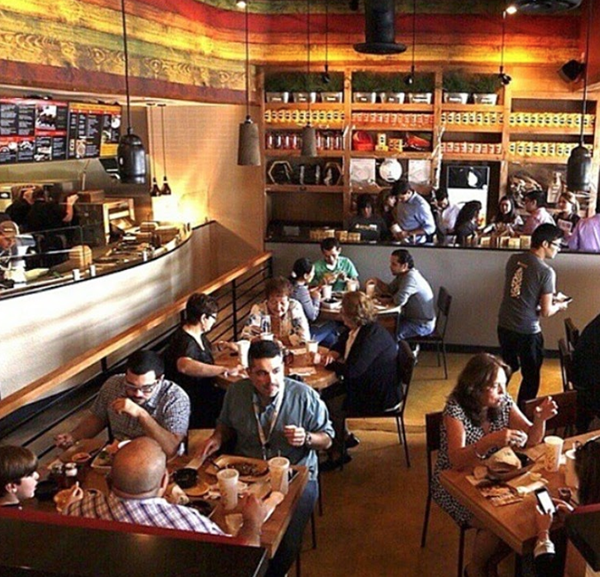Self-service kiosks and automated ordering stations have become more commonplace in both quick-service and fast-casual restaurants. Following the lead of supermarket self-checkout stations, this equipment not only enhances speed of service, but also adds convenience and ensures order accuracy.
With the uptick in off-premises dining due to the pandemic and current labor concerns (find more on labor-saving design strategies here), kiosks and automated ordering stations have aided in improving guest experience.
From simple tablets and compact touch-screen kiosks to the more advanced artificial intelligence (AI) and recognition technology, there are a number of options for operators to consider.
Kiosks and automated ordering stations can help shift labor allocations, which allows employees to handle other tasks, as needed. For example, instead of manning a register, staff can be more easily deployed to the kitchen for prep, at the drive-thru for order taking, to the curb for pickups or in the front of house for cleaning.
Types & Formats
The majority of self-ordering kiosks are fully transactional, with customers ordering and paying at the same station. In many cases, these systems are connected to, and work in tandem with, point of sale systems (POS) and kitchen display systems (KDS).
Kiosks may take on a major role as the primary or sole ordering station or as a secondary option for those who don’t want to stand in line at the register. In both cases, these stations are situated on or near the front counter.
Depending on the model, kiosks and automated ordering stations offer floor, wall or counter mounting. While some are as simple as a tablet for countertop use, there are larger and more advanced stand-alone double-sided units as well. All perform similar tasks needed for self-ordering.
Touchscreens are common, with sizes ranging from 13 or 15 inches wide for tablets to between 19 and 27 inches wide for stand-alone kiosks. Depending on the model, screens may offer landscape and/or portrait layouts. These systems typically include printers, scanners and credit card readers. Intuitive software simplifies use and encourages add-ons for upselling.
Features & Options
The core function of kiosks is self ordering, with customers being able to navigate the menu, see prices and choose food items. The menu and pricing duplicate the POS and menu boards. Self-ordering kiosks are most effective when add-on options or upgrades are suggested, such as more toppings, a side, dessert or beverage.
For true self-service, these units include the ability to take payments. Receipt printing, part of the hardware, is optional since proof of payment can be sent digitally. To improve customer engagement and user experience, self-service kiosks can encourage customers to opt in to loyalty programs, where data on consumer behavior, usage and trends can be collected.
Integration is important, as kiosks are an extension of the POS system, which powers the content and transaction management. As such, the POS should receive complete transactions to route orders, document inventory, update financials, and other required data or metrics.
ADA (Americans with Disabilities Act) compliance also should be considered. Kiosks with a touch pad allow menu navigation with keys instead of a touchscreen for those with impaired vision. There also are units with audio jacks to plug in headsets. Software compatibility should be verified when incorporating these features.
Kiosks with restaurant transaction and experience platforms allow multi-unit operators to not only centrally manage menu items but also configure digital endpoints. This enables operators to set up and easily change menu items, including images, nutritional and allergen information, pricing and promotions and synchronize all the content in real time across mobile apps, the website, third-party delivery providers, digital menu boards, order confirmation boards and self-service kiosks. These enterprise management systems also can set up multiple zones and revenue centers. Operators can display partial menus in one location then monitor and measure revenue.
New Technologies
Kiosks can also be used as part of the entire restaurant automation system. Working with KDS and as part of the POS, it can keep track of inventory, and offer more advanced marketing capabilities.
When employed, AI can detect returning customers and customize add-on suggestions based on past orders. AI can also personalize visible menus utilizing a camera, pin number or biometric sensor. It has been shown that integrating AI into self-ordering kiosks can increase ticket amounts by 15% to 30%.
In addition, newer self-ordering programs can collect customer data, like email addresses and phone numbers. Loyalty programs also can be incorporated and automated through these systems.
Power packs or multi organizational databases can be incorporated into self-serve stations. These save customer information, like past orders and even state IDs for bars, and make this available to all chain locations.
Adaptable kiosk suites are available that operate either alone or as part of a larger fleet and provide menu interaction and self-ordering features.
Units that centralize menu and order management, while also providing branding and multilingual support with a customer loyalty program are available.
Customizable self-ordering platforms provide automatic upsells and promotions, discount code integration, and personalized menus including the option to quickly edit product names and descriptions as well as add photos and videos.
Purchasing Considerations
Budget and brand experience are the primary factors when choosing a kiosk or automated ordering station. While less costly units like tablets are plug and play, stand-alone kiosks may have more extensive set up requirements. Operators should decide what financial commitment works best. Software can be purchased with a licensing contract or monthly subscription, and hardware can be purchased or leased.
The number of stations is another consideration and depends on an operation’s size and volume. While a smaller site may need only one station, a medium or larger operation would have between two and four. For stadiums and large foodservice outlets that solely rely on self ordering, five or six kiosks may be needed.
Placement is key, and operators should consider the site’s traffic pattern. Having kiosks front and center provides a psychological effect of prompting self ordering.
The system’s features and capabilities are paramount. Some kiosks allow users to create custom menu categories, configure item images and easily change menus in real time. Note that customers are more likely to order more food when images, personalized photos and videos of every item, condiment, add-on, and menu category are on the screen. Ensure menus automatically change for breakfast, lunch, dinner or for special occasions.
Because automatic upselling can increase average ticket size, a feature that promotes popular products, specials, add-ons, etc. can raise ticket totals. Find out if discount codes can be added on the back end and automatically translated to the front end so diners can enter any traditionally POS-supported discount or coupon code when using the kiosk. A feature where customers can be automatically notified via text or email when their order is ready offers added convenience.
Customer experience is dictated by the software. Operators must verify with software providers that the kiosk program supports the necessary functions and features and can be properly integrated. Software can be custom or standard, with cloud-based solutions now more common.
Available features, such as multi language support and loyalty program support should be factored in. Also consider warranties, service and support.
In addition, consider how the kiosk will be powered and how the device connects to the internet, as these are tantamount to consistent operation. If the router speed is lacking, an internet booster may be needed. A hot spot in the back of the unit will ensure there are no lapses in the internet connection and speed.
Operators should ensure appropriate payment options are integrated seamlessly with the kiosk experience. These may include credit cards, Apple Pay, Samsung Pay and/or Google pay. Verify rates and fees so payment processing costs are kept in line.



